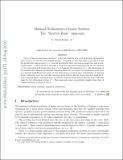| dc.contributor.author | Forney, G. David, Jr. | |
| dc.date.accessioned | 2012-09-20T17:42:03Z | |
| dc.date.available | 2012-09-20T17:42:03Z | |
| dc.date.issued | 2011-01 | |
| dc.date.submitted | 2010-07 | |
| dc.identifier.issn | 0018-9448 | |
| dc.identifier.uri | http://hdl.handle.net/1721.1/73076 | |
| dc.description.abstract | Given a discrete-time linear system C, a shortest basis for C is a set of linearly independent generators for C with the least possible lengths. A basis B is a shortest basis if and only if it has the predictable span property (i.e., has the predictable delay and degree properties, and is non-catastrophic), or alternatively if and only if it has the subsystem basis property (for any interval J, the generators in B whose span is in J is a basis for the subsystem CJ). The dimensions of the minimal state spaces and minimal transition spaces of C are simply the numbers of generators in a shortest basis B that are active at any given state or symbol time, respectively. A minimal linear realization for C in controller canonical form follows directly from a shortest basis for C, and a minimal linear realization for C in observer canonical form follows directly from a shortest basis for the orthogonal system C[superscript ⊥]. This approach seems conceptually simpler than that of classical minimal realization theory. | en_US |
| dc.language.iso | en_US | |
| dc.publisher | Institute of Electrical and Electronics Engineers (IEEE) | en_US |
| dc.relation.isversionof | http://dx.doi.org/10.1109/tit.2010.2094811 | en_US |
| dc.rights | Creative Commons Attribution-Noncommercial-Share Alike 3.0 | en_US |
| dc.rights.uri | http://creativecommons.org/licenses/by-nc-sa/3.0/ | en_US |
| dc.source | arXiv | en_US |
| dc.title | Minimal Realizations of Linear Systems: The "Shortest Basis" Approach | en_US |
| dc.type | Article | en_US |
| dc.identifier.citation | Forney, G. David. “Minimal Realizations of Linear Systems: The "Shortest Basis" Approach.” IEEE Transactions on Information Theory 57.2 (2011): 726–737. | en_US |
| dc.contributor.department | Massachusetts Institute of Technology. Department of Electrical Engineering and Computer Science | en_US |
| dc.contributor.mitauthor | Forney, G. David, Jr. | |
| dc.relation.journal | IEEE Transactions on Information Theory | en_US |
| dc.eprint.version | Author's final manuscript | en_US |
| dc.type.uri | http://purl.org/eprint/type/JournalArticle | en_US |
| eprint.status | http://purl.org/eprint/status/PeerReviewed | en_US |
| dspace.orderedauthors | Forney, G. David | en |
| mit.license | OPEN_ACCESS_POLICY | en_US |
| mit.metadata.status | Complete | |
